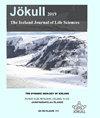用Sentinel-1卫星雷达图像连续监测冰岛的冰动态
IF 0.3
4区 地球科学
Q4 GEOSCIENCES, MULTIDISCIPLINARY
引用次数: 1
摘要
近年来,卫星遥感已经彻底改变了冰川动力学的观测,使冰岛冰川第一次能够定期生成详细的冰速场。我们利用偏移跟踪技术连续获取Sentinel-1 SAR数据,生成了2014 - 2020年冰速场的密集时间序列。在冰岛南部和东南部高降水地区的大海拔范围内,在冰帽的主要出口冰川的中下部观测到最快的冰流,其速度可达每年400-800米。Vatnajökull的几个出口冰川,如Skeiðarárjökull和Breiðamerkurjökull,流向南部和东南部,显示出高冰速通道和明显的剪切带,其中冰速仅在几个冰厚的距离内就增加了一个数量级。在N-和W-Vatnajökull的大型涌浪型出口冰川上,以及冰岛中部高地和该国北部和西部的冰川上,观测到的速度大约为每年几十米,每年可达50-100米。沿着主要的冰分界线和靠近冰川边缘的地方可以观察到缓慢移动的冰。由于雷达图像纹理的时间变化,速度数据集受到去相关的间隙的影响,特别是在夏季。本研究从Sentinel-1数据中得出的冰速度场与其他数据集吻合良好,尽管这些数据集受到大量异常值和数据空白的影响,特别是在积累区。生成的速度时间序列可用于监测长期动态趋势、季节变化和研究冰川事件,如涌浪或jökulhlaups。本文章由计算机程序翻译,如有差异,请以英文原文为准。
Continuous monitoring of ice dynamics in Iceland with Sentinel-1 satellite radar images
In recent years, satellite remote sensing has revolutionized observations of glacier dynamics enabling for the first time the generation of detailed ice-velocity fields at regular intervals for Icelandic glaciers. We generated dense time series of ice-velocity fields from 2014 to 2020 exploiting the continuous acquisition of Sentinel-1 SAR using the offset-tracking technique. The fastest ice flow, with velocities up to 400–800 metres per year, is observed in the middle and lower part of the main outlet glaciers of the ice caps that span a large elevation range in the areas of high precipitation in the South and Southeast of Iceland. Several outlet glaciers of Vatnajökull, such as Skeiðarárjökull and Breiðamerkurjökull, draining towards the South and Southeast, show high-ice-speed channels with pronounced shearing zones where the ice speed increases by an order of magnitude within a distance of only a few ice thicknesses. Velocities on the order of a few tens of metres per year, and up to 50–100 metres per year, are observed on the large surge-type outlet glaciers of N- and W-Vatnajökull and generally on glaciers in the central Icelandic highland and in the northern and western part of the country. Slow-moving ice is observed along the main ice divides and near the glacier margins. The velocity data set is affected by gaps due to decorrelation, particularly during summer, because of temporal variations in the radar-image texture. The ice-velocity fields derived in this study from Sentinel-1 data agree well with other data sets, although these are affected by a larger number of outliers and data gaps, particularly in the accumulation areas. The generated velocity time series can be used for monitoring long-term dynamic trends, seasonal variations and for studying glaciological events such as surges or jökulhlaups.
求助全文
通过发布文献求助,成功后即可免费获取论文全文。
去求助
来源期刊

Jokull
地学-地球科学综合
自引率
22.20%
发文量
1
审稿时长
1 months
期刊介绍:
Jökull publishes research papers, notes and review articles concerning all aspects of the Earth Sciences. The
journal is primarily aimed at being an international forum
for geoscience research in Iceland. Specific areas of coverage include glaciology, glacial geology, physical geography,
general geology, petrology, volcanology, geothermal research, geophysics, meteorology, hydrology and oceanography. Jökull also publishes research notes and reports from
glacier expeditions, book reviews, and material of interest to
the members of the Icelandic Glaciological and Geological
Societies
 求助内容:
求助内容: 应助结果提醒方式:
应助结果提醒方式:


